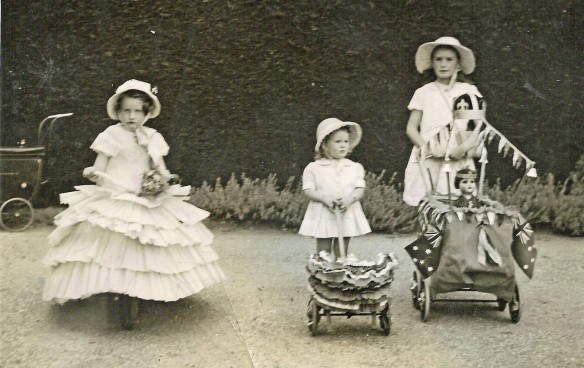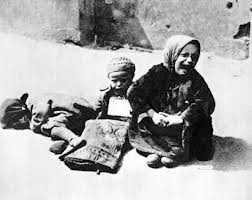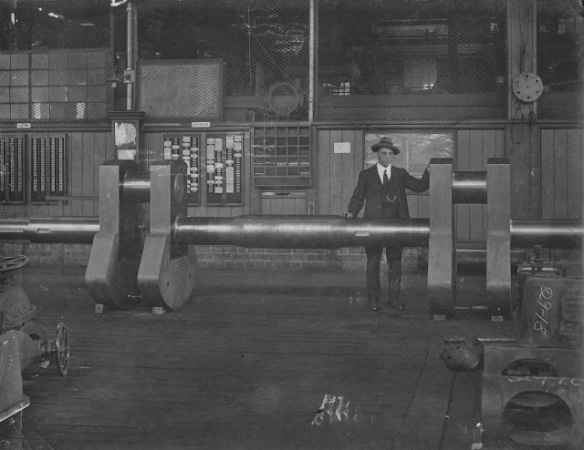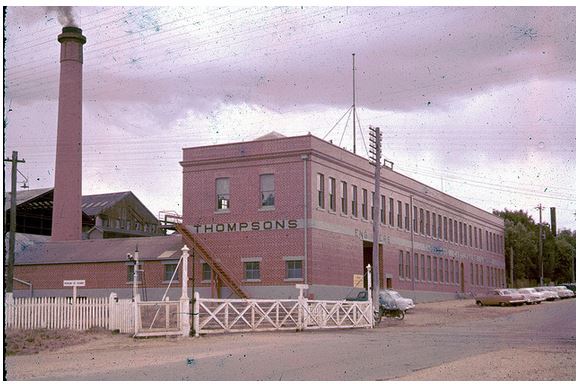Happy 200th birthday, Sepia Saturday.
 I have only been a member of Sepia Saturday for three months which is only 7% of its lifetime. So I was hesitant about re-publishing a post which was only made two months ago. But writing the post was a revelation to me as I started researching what was happening on the date which was written on the photo. This is a method I will continue to use whenever I know when a photo was taken but hopefully won’t be quite as long-winded in future.
I have only been a member of Sepia Saturday for three months which is only 7% of its lifetime. So I was hesitant about re-publishing a post which was only made two months ago. But writing the post was a revelation to me as I started researching what was happening on the date which was written on the photo. This is a method I will continue to use whenever I know when a photo was taken but hopefully won’t be quite as long-winded in future.
Our theme for today is groups of three. These three girls were prizewinners at Mrs Burnell’s garden party.in Castlemaine, Central Victoria, on Nov 16th, 1940 . It was part of the way into World War II, when raising money for war effort charities such as the Comfort Fund, Red Cross or Bundles for Britain was the usual reason for holding a money-raising event. It was such a patriotic time, not so long after the last coronation and a new king, with the country at war. Best dresses and hats were brought out for this special occasion, and the pram reflects the feeling at the time with its crown, its Australian flags and red, white and blue bunting.. Crepe paper was the standard material for these creations, willingly constructed by parents. . And the special doll Elizabeth was named ,of course, after Princess Elizabeth.
A typical pretty, peaceful, family album picture of the time. But it is what the picture doesn’t show which makes it interesting to me. When the two girls on the right got out of bed that morning they had probably been primed to wish their mother a happy birthday. It was her forty-first birthday. But they would have been blissfully unaware of the reaction of their parents when they opened their morning newspaper of choice, the Argus, from Melbourne, and its news of the war from England. .Two nights before the worst bombing raid on the city of Coventry was carried out. Over 4000 homes were destroyed and over 500 people killed. Coventry was the home of the children’s 90 year old maternal great grandmother. I don’t know long it was to be before the Australian family found out that she was alive and well and was to live for another two years. Then on the night of the garden party the Royal Air Force retaliated by bombing Hamburg.
But the children weren’t aware of this.
Also on the other side of the world and on that same day the Warsaw ghetto was closed to the outside world by the Nazis. In the previous month the Jewish people of Warsaw, about one third of the total population , had been rounded up by the Nazis and confined to a small are of the city, These 400,000 people were held behind three metre high walls topped with barbed wire. And on this fatal day the gap was closed. Thirty percent of the population crowded into two and a half percent of the area.
But the children in Castlemaine weren’t aware of this
or of a group of three children in the ghetto in Warsaw,
The garden party was held at the home of Mr and Mrs Burnell, a beautiful home with a large front lawn suitable for all the stalls and competitions that go with a fund-raising garden party. It was directly across the road from Thompson’s Englineering & Pipe Works, established in 1875, where Mr Burnell was the General Manager. He had won the MC during WorldWar I. Thompson’s was the most important business in Castlemaine, commonly known as Thompson’s Foundry and was spread out alongside the main railway line from Melbourne to Bendigo, an ideal position for transporting the heavy goods which it made, a wide range of steam-engines, boilers, mining machinery, railway equipment and centrifugal pumps. But during World War II they made artillery and tank guns, marine engines, circulating pumps and other heavy forging and foundry work.
Making guns for war, what the children didn’t know.
The eldest girl in the photos remembers the workmen on their pushbikes, four and five abreast, sweeping up and down the Main Street on their way to and from work. With such a large work force the foundry had a piercing whistle which screamed out at 7.00am, 7.20am and 7.30am. There was no excuse for being late for work and the whole town and beyond had its own non-negotiable alarm clock.
Small towns are such a web of people and places. The mother of the two girls on the right had originally come to Castlemaine with her parents as from 1923 to 1928 her father worked in the office at Thompson’s and was Bandmaster of Thompson’s Foundry Band. This is the same man who brought a book on Shakespeare with him when he came to Australia. The man really did have itchy feet and jumped as bandmaster from one small country town to another several times. The Foundry has had its own brass band since 1887 and 24 members of the band served in World War I, six of whom were killed. I have no figures for the Second World War.
When is the world going to learn .
And for more interesting stories about groups of three, click on the links in Sepia Saturday.







Excellent choice.
LikeLike
A very appropriate post for this weekend. I come up with these same questions too. What were other people doing at the same moment as this photo? I suppose it is the nature of the human condition that garden parties occur simultaneous as horrible tragedies.
Somehow I missed your earlier post on your grandfather’s book of Shakespeare and the wonderful photo of his band. Knowing the detail of the older bandsman – his age, wife’s name, and inscription on the book, adds a priceless value to a photograph. Make sure to print your post and keep a copy with the book and photo. Just this week I acquired a musical photo that would have been just another unknown musician, except the seller included a promotional stationary with the musician’s name. In 10 minutes I found a newspaper report from 1902 that confirmed a time and place.
LikeLike
Your photos are so inspiring, and I remember them all. Especially the first one with all happiness they felt that day I’m sure, and my heart goes out for the little one crying out! A perfect choice!
LikeLike
I like the idea of researching local and world events to help put your family photos in context. What a contrast you discovered here.
LikeLike
I remember this – how great to look so far into what was happening on that day and point out how blissfully unaware children are.
LikeLike
This is a post I shall always remember as the lines about the children being unaware of this reverberate through time.
LikeLike
I think the way you’ve contrasted the different experiences and understanding is fascinating and innovative. A great post for the 200th birthday series.
LikeLike
I like the idea of putting the photo in context of world events and I may have to employ that method myself. This is a worthy entry for the book.
LikeLike
Being a young blogger is a good thing and you are full of ideas and plans to create blogs. The old timers of the group are still very creative but we have to search a little longer and harder to get fresh material. Great post.
LikeLike
I’ve messaged you in Facebook. It may have gone into your ‘other’ folder.
LikeLike
Great choice. I enjoyed it again. Very well written
LikeLike
The second and third shots were chilling!
LikeLike
I was fascinated as I read this post. Parallel lives lived thousands of miles apart with no knowledge of the other’s existence, living lives that will never touch — except in a post like this. Thanks for sharing it and giving us another perspective. The three party girls are adorable, the three desolate girls are heart-wrenching.
LikeLike
This post is so perceptive and poignant. I remember it well.
LikeLike
A very moving piece this was.
Thanks for sharing [again]!!
🙂
HUGZ
LikeLike